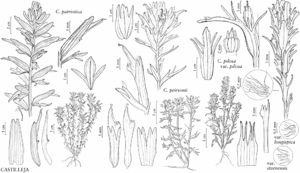Castilleja peirsonii
Leafl. W. Bot. 1: 175. 1935. (as peirsoni)
Herbs, perennial, 0.6–3(–4) dm; from a woody caudex; with a taproot. Stems few to several, erect or ascending, unbranched, sometimes branched, hairs dense distally, less so proximally, spreading, long, soft, eglandular, also mixed with short stipitate-glandular ones distally. Leaves green to purple, narrowly to broadly lanceolate to oblong, (0.7–)1.5–4.2(–5) cm, not fleshy, margins plane, flat or involute, (0–)3(–5)-lobed, apex acuminate; lobes ascending-spreading, narrowly lanceolate to linear, apex acute. Inflorescences 2.5–7.5(–15) × 1.5–3 cm; bracts proximally greenish to dull reddish, distally bright red, orange, or pale orange, sometimes yellowish or dull red, broadly lanceolate to oblong, 3–5-lobed; lobes ascending, linear to lanceolate, ± long, arising above mid length, sometimes below mid length on proximal bracts, central lobe apex acute, rarely narrowly obtuse, lateral ones acute. Calyces proximally light green or yellow, distally yellow or colored as bracts, 12–20 mm; abaxial and adaxial clefts 5–9 mm, 40–50% of calyx length, deeper than laterals, lateral (1.5–)3–5.8 mm, 10–30% of calyx length; lobes oblong, apex acute to obtuse. Corollas slightly curved, 15–28 mm; tube 13–15 mm; beak exserted, adaxially yellow or yellow-green, 7–8 mm; abaxial lip yellow or deep green, reduced, slightly inflated, pouched, protruding out abaxial cleft, 1–2.5 mm, 13–33% as long as beak; teeth erect or curved, yellow or green, 0.7–1 mm. 2n = 24.
Phenology: Flowering Jun–Sep.
Habitat: Moist to wet meadows, stream banks, lakeshores, montane to alpine.
Elevation: 1700–3400 m.
Distribution
Calif., Nev.
Discussion
Castilleja peirsonii is endemic to the higher elevations in the Sierra Nevada of California and in Tahoe Meadows in adjacent Washoe County, Nevada. Plants with yellow bracts in the southern portion of the range were named C. carterae. Castilleja peirsonii has shorter, wider corolla beaks than the related C. parviflora. In addition to the corolla shape differences, C. peirsonii also has red to yellow bracts and fairly bright yellow corollas, especially on the beaks, while C. parviflora has purple, pink, or white bracts and greenish corolla tubes and dorsal beak surfaces, with the beak margins pink, purple, or white. Reports from outside the Sierra Nevada in California and immediately adjacent Nevada are misidentifications. Castilleja peirsonii sometimes hybridizes with C. lemmonii in meadows where both species often occur in large numbers.
Selected References
None.
